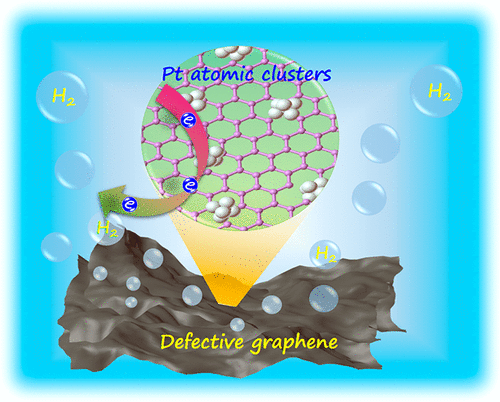当前位置:
X-MOL 学术
›
J. Am. Chem. Soc.
›
论文详情
Our official English website, www.x-mol.net, welcomes your
feedback! (Note: you will need to create a separate account there.)
Carbon-defect-driven electroless deposition of Pt atomic clusters for highly efficient hydrogen evolution
Journal of the American Chemical Society ( IF 14.4 ) Pub Date : 2020-02-23 , DOI: 10.1021/jacs.9b11524 Qingqing Cheng 1, 2, 3 , Chuangang Hu 2, 4 , Guoliang Wang 1 , Zhiqing Zou 1 , Hui Yang 1, 5 , Liming Dai 2, 4
Journal of the American Chemical Society ( IF 14.4 ) Pub Date : 2020-02-23 , DOI: 10.1021/jacs.9b11524 Qingqing Cheng 1, 2, 3 , Chuangang Hu 2, 4 , Guoliang Wang 1 , Zhiqing Zou 1 , Hui Yang 1, 5 , Liming Dai 2, 4
Affiliation

|
Pt atomic clusters (Pt-ACs) display outstanding electrocatalytic performance because of their unique electronic structure with a large number of highly exposed surface atoms. However, the small size and large specific surface area intrinsically associated with ACs pose challenges in the synthesis and stabilization of Pt-ACs without agglomeration. Herein, we report a novel one-step carbon-defect-driven electroless deposition method to produce ultrasmall but well-defined and stable Pt-ACs supported by defective graphene (Pt-AC/DG) structures. A theoretical simulation clearly revealed that the defective regions with a lower work function, and hence a higher reducing capacity, than that of normal hexagonal sites triggered the reduction of Pt ions preferentially at the defect sites. Moreover, the strong binding energy between Pt and carbon defects effectively restricted the migration of spontaneously reduced Pt atoms to immobilize/stabilize the resultant Pt-ACs. Electrochemical analyses demonstrated the high performance of Pt-ACs in catalyzing the hydrogen evolution reaction, showing a greatly enhanced mass activity, a high Pt utilization efficiency, and an excellent stability compared with commercial Pt/C catalysts. The integration of proton exchange membrane water electrolysis with Pt-AC/DG as a cathode exhibited excellent hydrogen generation activity and extraordinary stability (during 200 hours of electrolysis) with greatly reduced Pt usage compared with commercial Pt/C catalysts.
中文翻译:

碳缺陷驱动的 Pt 原子簇化学沉积用于高效析氢
Pt 原子团簇 (Pt-ACs) 由于其独特的电子结构和大量高度暴露的表面原子而显示出出色的电催化性能。然而,与 ACs 内在相关的小尺寸和大比表面积对 Pt-ACs 的合成和稳定化提出了挑战,而不会发生团聚。在此,我们报告了一种新的一步碳缺陷驱动的化学沉积方法,以生产由缺陷石墨烯(Pt-AC/DG)结构支撑的超小但定义明确且稳定的 Pt-AC。理论模拟清楚地表明,与正常六边形位点相比,具有较低功函数的缺陷区域,因此具有更高的还原能力,优先在缺陷位点触发 Pt 离子的还原。而且,Pt 和碳缺陷之间的强结合能有效地限制了自发还原的 Pt 原子的迁移,以固定/稳定所得的 Pt-AC。电化学分析表明 Pt-ACs 在催化析氢反应方面的高性能,与商业 Pt/C 催化剂相比,显示出大大提高的质量活性、高 Pt 利用率和优异的稳定性。与商业 Pt/C 催化剂相比,质子交换膜水电解与 Pt-AC/DG 作为阴极的集成表现出优异的制氢活性和非凡的稳定性(在 200 小时的电解期间),并且大大降低了 Pt 的使用量。电化学分析表明 Pt-ACs 在催化析氢反应方面的高性能,与商业 Pt/C 催化剂相比,显示出大大提高的质量活性、高 Pt 利用率和优异的稳定性。与商业 Pt/C 催化剂相比,质子交换膜水电解与 Pt-AC/DG 作为阴极的集成表现出优异的制氢活性和非凡的稳定性(在 200 小时的电解期间),并且大大降低了 Pt 的使用量。电化学分析表明 Pt-ACs 在催化析氢反应方面的高性能,与商业 Pt/C 催化剂相比,显示出大大提高的质量活性、高 Pt 利用率和优异的稳定性。与商业 Pt/C 催化剂相比,质子交换膜水电解与 Pt-AC/DG 作为阴极的集成表现出优异的制氢活性和非凡的稳定性(在 200 小时的电解期间),并且大大降低了 Pt 的使用量。
更新日期:2020-02-23
中文翻译:

碳缺陷驱动的 Pt 原子簇化学沉积用于高效析氢
Pt 原子团簇 (Pt-ACs) 由于其独特的电子结构和大量高度暴露的表面原子而显示出出色的电催化性能。然而,与 ACs 内在相关的小尺寸和大比表面积对 Pt-ACs 的合成和稳定化提出了挑战,而不会发生团聚。在此,我们报告了一种新的一步碳缺陷驱动的化学沉积方法,以生产由缺陷石墨烯(Pt-AC/DG)结构支撑的超小但定义明确且稳定的 Pt-AC。理论模拟清楚地表明,与正常六边形位点相比,具有较低功函数的缺陷区域,因此具有更高的还原能力,优先在缺陷位点触发 Pt 离子的还原。而且,Pt 和碳缺陷之间的强结合能有效地限制了自发还原的 Pt 原子的迁移,以固定/稳定所得的 Pt-AC。电化学分析表明 Pt-ACs 在催化析氢反应方面的高性能,与商业 Pt/C 催化剂相比,显示出大大提高的质量活性、高 Pt 利用率和优异的稳定性。与商业 Pt/C 催化剂相比,质子交换膜水电解与 Pt-AC/DG 作为阴极的集成表现出优异的制氢活性和非凡的稳定性(在 200 小时的电解期间),并且大大降低了 Pt 的使用量。电化学分析表明 Pt-ACs 在催化析氢反应方面的高性能,与商业 Pt/C 催化剂相比,显示出大大提高的质量活性、高 Pt 利用率和优异的稳定性。与商业 Pt/C 催化剂相比,质子交换膜水电解与 Pt-AC/DG 作为阴极的集成表现出优异的制氢活性和非凡的稳定性(在 200 小时的电解期间),并且大大降低了 Pt 的使用量。电化学分析表明 Pt-ACs 在催化析氢反应方面的高性能,与商业 Pt/C 催化剂相比,显示出大大提高的质量活性、高 Pt 利用率和优异的稳定性。与商业 Pt/C 催化剂相比,质子交换膜水电解与 Pt-AC/DG 作为阴极的集成表现出优异的制氢活性和非凡的稳定性(在 200 小时的电解期间),并且大大降低了 Pt 的使用量。















































 京公网安备 11010802027423号
京公网安备 11010802027423号